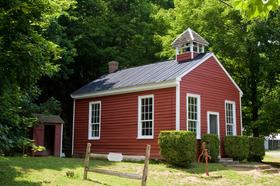Top Rankings
Ramapo Indian Hills Regional High School District ranks among the top 20% of public school district in New Jersey for:
Category
Attribute
Graduation Rate
Highest graduation rate (Top 20%)
For the 2025 school year, there are 2 public high schools serving 1,882 students in Ramapo Indian Hills Regional High School District. This district's average high testing ranking is 9/10, which is in the top 20% of public high schools in New Jersey.
╬█╬█┬■╗ş High Schools in Ramapo Indian Hills Regional High School District have an average math proficiency score of 47% (versus the New Jersey public high school average of 28%), and reading proficiency score of 65% (versus the 47% statewide average).
╬█╬█┬■╗ş High School in Ramapo Indian Hills Regional High School District have a Graduation Rate of 94%, which is more than the New Jersey average of 85%.
The school with highest graduation rate is Ramapo High School, with 96% graduation rate. Read more about public school graduation rate statistics in New Jersey or national school graduation rate statistics.
Minority enrollment is 17% of the student body (majority Hispanic), which is less than the New Jersey public high school average of 63% (majority Hispanic).
Overview
This School District
This State (NJ)
# Schools
2 Schools
548 Schools
# Students
1,882 Students
467,298 Students
# Teachers
198 Teachers
36,806 Teachers
Student : Teacher Ratio
10:1
10:1
Student By Grade
District Rank
Ramapo Indian Hills Regional High School District, which is ranked within the top 30% of all 646 school districts in New Jersey (based off of combined math and reading proficiency testing data) for the 2021-2022 school year.
The school district's graduation rate of 94% has decreased from 97% over five school years.
Overall District Rank
#183 out of 650 school districts
(Top 30%)
(Top 30%)
Math Test Scores (% Proficient)
46%
36%
Reading/Language Arts Test Scores (% Proficient)
65%
49%
Science Test Scores (% Proficient)
35%
23%
Graduation Rate
94%
85%
Students by Ethnicity:
Diversity Score
0.31
0.72
% American Indian
n/a
n/a
% Asian
5%
10%
% Hispanic
9%
34%
% Black
1%
17%
% White
83%
37%
% Hawaiian
n/a
n/a
% Two or more races
2%
2%
All Ethnic Groups
District Revenue and Spending
The revenue/student of $36,338 is higher than the state median of $26,931. The school district revenue/student has grown by 17% over four school years.
The school district's spending/student of $33,772 is higher than the state median of $25,828. The school district spending/student has grown by 17% over four school years.
Total Revenue
$68 MM
$36,642 MM
Spending
$64 MM
$35,142 MM
Revenue / Student
$36,338
$26,931
Spending / Student
$33,772
$25,828
Best Ramapo Indian Hills Regional High School District ╬█╬█┬■╗ş High Schools (2025)
School
(Math and Reading Proficiency)
(Math and Reading Proficiency)
Location
Grades
Students
Rank: #11.
Indian Hills High School
(Math: 50-54% | Reading: 65-69%)
Rank:
Rank:
8/
Top 30%10
97 Yawpo Ave
Oakland, NJ 07436
(201) 337-0100
Oakland, NJ 07436
(201) 337-0100
Grades: 9-12
| 694 students
Rank: #22.
Ramapo High School
(Math: 44% | Reading: 63%)
Rank:
Rank:
7/
Top 50%10
331 George Street
Franklin Lakes, NJ 07417
(201) 891-1500
Franklin Lakes, NJ 07417
(201) 891-1500
Grades: 9-12
| 1,188 students
Recent Articles

Segregation in K-12 Education: Colonial Era
Explore the origins of educational segregation during the colonial era and the differential treatment of Native American, African American, and white students. This article delves into the historical context, policies, and societal attitudes that shaped early education in colonial America, highlighting the disparities and injustices that persisted within the schooling systems of that time.

2011 Classroom Size Update: Are Classes Still Growing Larger?
Since the recession, public school classrooms have seen major budget cuts - and many increases in class sizes. How is the situation in 2011? Read this article to find out.

Will Single Sex Classrooms Save ╬█╬█┬■╗ş Schools?
Learn about the benefits of single sex classrooms and why public schools are hoping this type of classroom will save the American school system.





